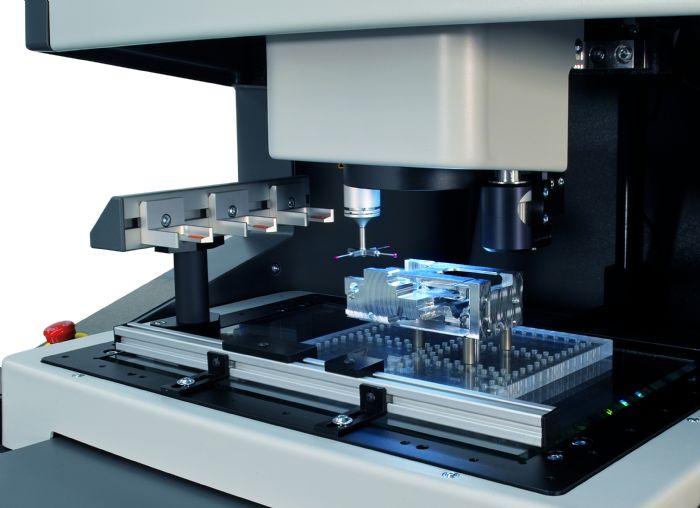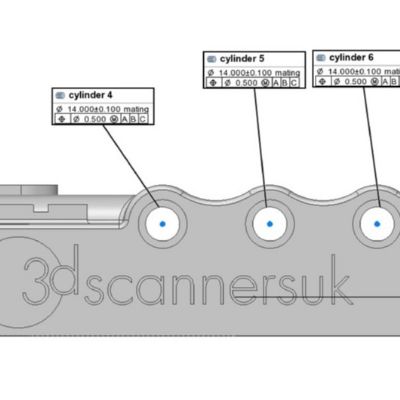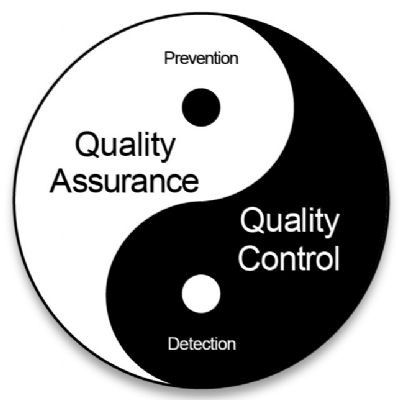These inline and near-line vision systems prove remarkably hardy and able to handle most temperature environments encountered on the stamping-shop floor. Further easing shop-floor incorporation, these systems often contain their own light sources, matched in color and intensity, and positioned to most effectively capture and render part and feature images.
The systems carry their own lighting due to the need for pixel clarity.
|
Is inline or near-line inspection ideal for your small, precision parts? Jonathan O’Hare, global program manager of CT systems at Hexagon Manufacturing Intelligence, suggests asking the following questions when exploring the measurement/inspection path for determining the level of needed capability:
|
“The image area is lit from different directions, and then a series of LEDs around the camera lens enables users to provide light in various orientations,” O’Hare explains, citing typical flexible setups. “The system is calibrated for a particular type of lighting, a particular type of camera and other factors. No need for users to set up unique shop-floor lighting.”
Setups Tailored to Feature Measurement Needs
Applications of this technology abound for precision metal formers, as vision systems find use in batch and continuous forming and assembly operations for electronic consumer goods and medical devices, among others. Electronics for mobile phones offer a typical example.
“Mobile phones feature small switches and similar parts as well as supports and framing to house the various components in an assembly,” says O’Hare. “The hole locations in these small stamped parts, for example, must be precise to ensure proper assembly, and vision systems can measure for the needed tolerances within the process.”
Some specialized systems for inline image processing place cameras at multiple angles, taking quick images of parts coming through on a conveyor. In some cases, cameras capture images with the parts in motion—no need to stop the line for each image.
“Taking images from different angles via multiple cameras allow capture of edges and other features not normally visible when capturing with a straight-on camera setup,” O’Hare says. “In a matter of seconds, data are collected and analyzed. An electronics part such as a completely flat backplate can be measured with a single, straight-on camera. But multi-camera and multi-sensor systems can be used for more-complex stamped parts with features on more than one side. These systems will measure everything in a single setup, and typically are found in medical-device components that require exceptionally high quality control.”
Such applications might employ multiple measurement methods, according to O’Hare, including a CCD camera to measure straight ahead—say, to confirm hole locations on one part face—and other methods for more challenging side features such as the depth of a groove.
“Here, a focal white-light sensor may be employed,” he says. “Though more expensive, this sensor is highly accurate, providing precise depth measurement.” Such multi-sensor capabilities, notes O’Hare, are found in the Optiv Performance CMMs offered by Hexagon Manufacturing Intelligence.
 Incorporation of various measurement methods point to the complementary nature of inspection technology and its availability to metal formers, enabling use in all manner of applications. Optical systems may employ the aforementioned touch probes in near-line inspection to measure deep features, a task impossible with optical measurement alone, and/or employing the white-light sensors for tinier depth features.
Incorporation of various measurement methods point to the complementary nature of inspection technology and its availability to metal formers, enabling use in all manner of applications. Optical systems may employ the aforementioned touch probes in near-line inspection to measure deep features, a task impossible with optical measurement alone, and/or employing the white-light sensors for tinier depth features.
What’s clear is this: If a metal former requires feature measurement, inline and near-line systems possess the range and capability to get it done. MF
See also: Hexagon Manufacturing Intelligence
Technologies: Quality Control
Comments
Must be logged in to post a comment. Sign in or Create an Account
There are no comments posted. Quality Control
Quality ControlOnline GD&T Training
Tuesday, October 29, 2024
Use Lean Six Sigma for Efficiency & Quality Improvement
Daniel Schaeffler Friday, October 27, 2023
 Management
ManagementSeeking Small Victories: Continuous Process Improvement
Daniel Schaeffler Monday, September 25, 2023
 Quality Control
Quality ControlAn Introduction to Quality Management Systems
Daniel Schaeffler Thursday, July 27, 2023







 To learn how to measure while staying on schedule, MetalForming reached out to Jonathon O’Hare, global program manager of CT systems at Hexagon Manufacturing Intelligence, which provides measurement equipment for shop-floor and quality-room use. Drawing on experience in working with such metal formers, O’Hare explains why vision systems placed in production lines and nearby, often outfitted with cameras and augmented by final-inspection quality-control-lab equipment, provide for effective measurement solutions.
To learn how to measure while staying on schedule, MetalForming reached out to Jonathon O’Hare, global program manager of CT systems at Hexagon Manufacturing Intelligence, which provides measurement equipment for shop-floor and quality-room use. Drawing on experience in working with such metal formers, O’Hare explains why vision systems placed in production lines and nearby, often outfitted with cameras and augmented by final-inspection quality-control-lab equipment, provide for effective measurement solutions.